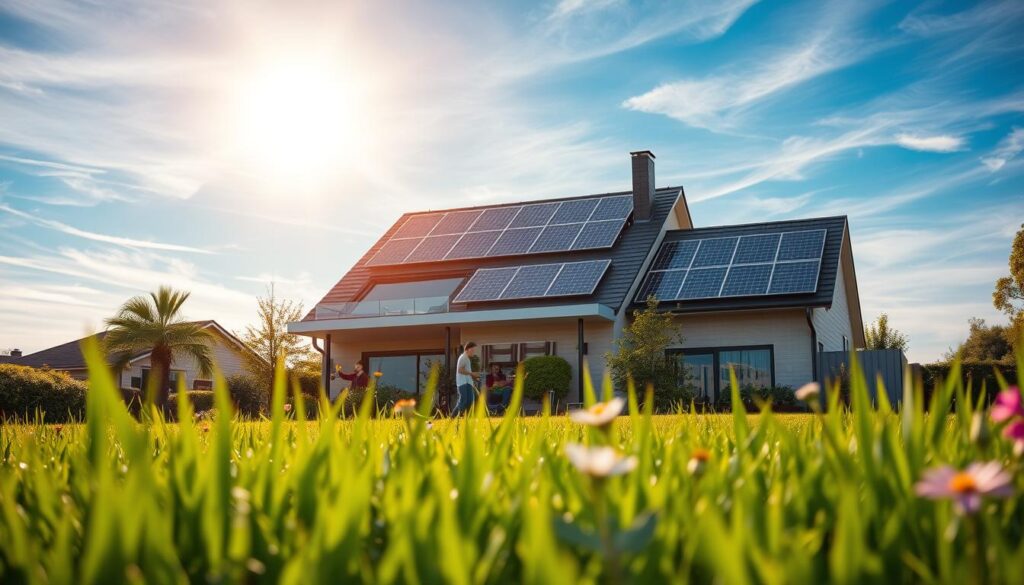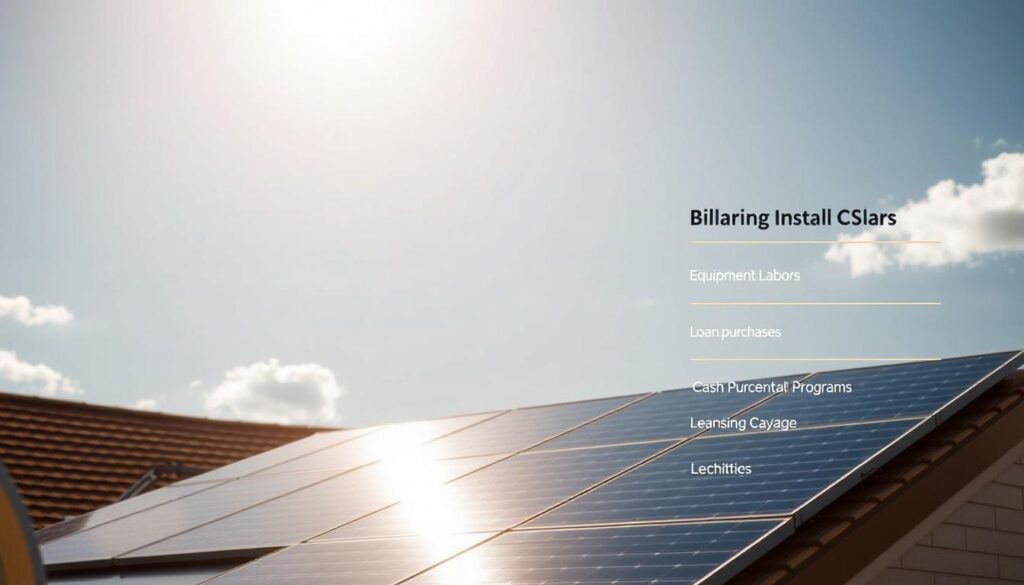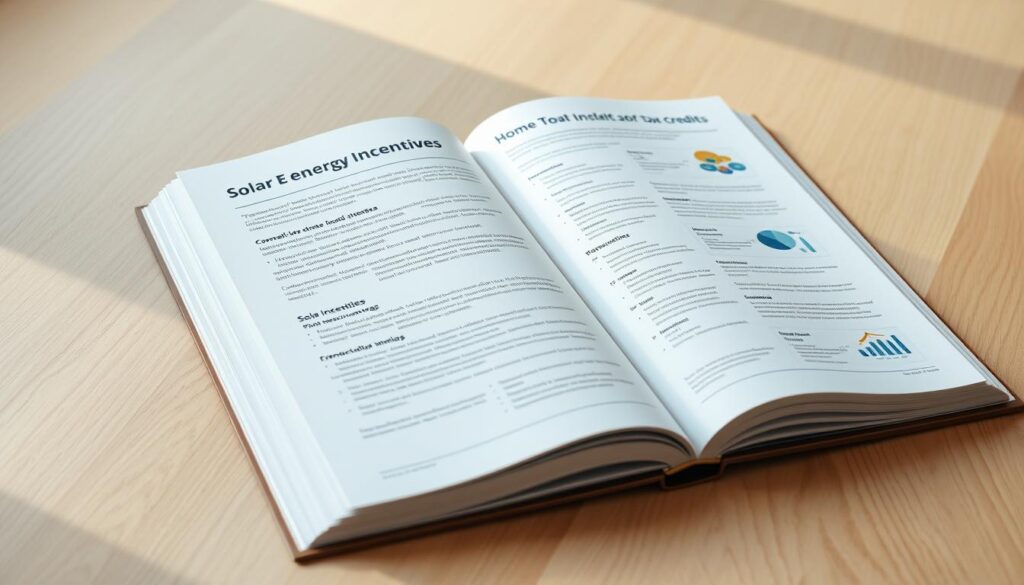Over the past decade, home solar has become a top choice for energy-smart homeowners. Since 2008, hundreds of thousands of residential solar power systems have been installed nationwide, driven by cost reductions of over 50% and federal support. The U.S. Department of Energy’s research has made these systems affordable, enabling families to harness clean energy while cutting utility bills.
Residential solar power now offers tangible savings and environmental benefits. Systems last 25-40 years, producing zero-emission energy while qualifying for federal tax credits. With incentives like the 30% Solar Investment Tax Credit (ITC), solar investments pay for themselves in 6-10 years, transforming homes into energy-efficient spaces.
Key Takeaways
- Home solar cuts energy bills by 20-30%, saving $1,000-$1,500 annually.
- The federal tax credit reduces costs by 30% through the Solar Investment Tax Credit (ITC).
- Residential solar power systems last 25-40 years with performance warranties.
- Installing solar boosts home value by 4-5%, adding $12,000-$15,000 to a $300,000 home.
- Over 81,000 systems installed by Qmerit prove solar’s reliability and growing adoption.
Understanding Home Solar Power: The Basics
Home solar technology turns sunlight into electricity through science anyone can grasp. At its core, solar energy systems use photovoltaic (PV) cells made from silicon to capture sunlight. These cells work like tiny power plants, creating direct current (DC) electricity when photons hit their surface.
“The photovoltaic effect was first observed in 1839, but it took over a century for this discovery to power homes.”
- Sunlight hits the solar panels installed on rooftops or open spaces.
- PV cells convert sunlight into DC electricity.
- An inverter changes DC into alternating current (AC) used in homes.
| Grid-Connected | Off-Grid |
|---|---|
| Connects to local power grids | Standalone with battery storage |
| Uses net metering for credit | No utility bill reliance |
| Lower upfront cost | Batteries add expense |
A complete solar energy system includes:
- Photovoltaic panels (60-72 cells per module)
- Inverters to convert electricity
- Mounting racks and wiring
- Monitoring equipment
Most systems last 25+ years with minimal maintenance. Modern panels retain 80% efficiency over their lifetime, backed by manufacturer warranties. Choosing between grid-tied or off-grid depends on energy needs and budget. Whether powering a home or reducing utility dependence, solar energy systems offer flexible solutions for modern living.
The Environmental Impact of Switching to Residential Solar Power
Residential solar power systems cut carbon emissions by replacing fossil fuels with clean energy. A typical home solar installation can reduce annual CO₂ output by 3 to 5 tons—the equivalent of planting 100 trees yearly. Every kilowatt-hour generated by panels displaces pollution from coal or gas plants.

Switching to solar power could save up to 25,000 lives annually by reducing harmful pollutants like sulfur dioxide and nitrogen oxides, according to recent studies.
- Home solar reduces smog-forming emissions linked to respiratory illnesses.
- Solar avoids water depletion caused by coal plant cooling systems.
- Residential solar preserves ecosystems by minimizing mining for coal or fracking for natural gas.
Modern recycling programs recover 90% of panel materials, including silver and glass, ensuring sustainability. Plus, solar’s on-site energy production eliminates grid-related transmission losses, boosting efficiency by 5–10%. By choosing home solar, households directly support cleaner air, habitat protection, and a healthier planet. This shift isn’t just good for the environment—it’s a step toward a resilient, sustainable energy future.
Financial Benefits of Home Solar Installation
Switching to home solar brings more than just clean energy—it delivers real financial rewards. Over 25 years, the average household saves $20,000 to $96,000 on utility bills. Solar panel installation costs are dropping, but the long-term gains make it a smart investment. Let’s break down how solar energy systems boost your bottom line.
Long-Term Energy Savings Analysis
Monthly electricity bills shrink immediately. Enact customers report cuts of 75% or more. With a 30% federal tax credit (available until 2032), upfront costs drop further. A 5kW system could cut $150 monthly bills by half, saving over $1,000 yearly. Multiply that over 25 years, and the math adds up fast.
Increase in Property Value
A 2019 Zillow study found solar-equipped homes sold 4.1% higher than non-solar homes, averaging $9,274 more.
Buyers pay premiums for solar. Studies show homes with solar panel installation sell 10 days faster and gain up to $15,000 in equity. Lenders even factor solar panels into home appraisals like any major upgrade.
Breaking Down Return on Investment
- Average payback period: 4–10 years
- Systems last 25+ years, producing free energy post-payback
- State incentives like SRECs add extra income from excess energy sales
After 10 years, solar panels generate free power while utility rates rise. Pair this with federal credits and rising home equity, and the ROI becomes clear. Solar isn’t just eco-friendly—it’s a lasting asset that pays you back.
Navigating Solar Panel Costs and Financing Options
Navigating the cost of solar energy for your home starts with knowing the numbers. Over the past decade, solar panel cost has dropped by over 50%, and federal incentives like the 30% tax credit make solar panel installation more affordable than ever. Let’s break down the key details to help you budget and choose the best path.
Average Home Solar Panel Costs in 2023

In 2023, a typical 11-kW solar system costs around $22,022 before tax credits. Prices vary based on roof type, panel efficiency, and local labor rates. Most residential systems range from $10,000 to $18,000, excluding tax savings. A 5kW system for smaller homes might start at $8,500, while larger homes could need 15kW or more.
Solar Loans, Leases, and Power Purchase Agreements
- Cash purchases: Pay upfront and save long-term with the 30% federal tax credit (up to 2033).
- Loans: Terms from 5-25 years. Interest is tax-deductible if using a home equity loan.
- Leases/PPAs: Pay a monthly fee instead of upfront costs. Example: A $100/month lease over 20 years totals $24,000.
“Solar loans let you own the system, while leases let you pay as you use energy—each option has pros and cons to weigh.”
Hidden Costs to Consider Before Installation
Beyond the system price, factor in:
- Rooftop repairs (if needed before installation)
- Electrical upgrades for older homes
- Permit fees (averaging $500-$1,000)
- Annual maintenance (typically $100–$300)
These details ensure your budget stays realistic from day one.
Federal and State Solar Incentives Available to Homeowners
Going solar just got easier with federal and state solar incentives designed to lower costs. The federal Investment Tax Credit (ITC) currently offers 30% of installation costs as a tax credit for systems installed by December 31, 2032. After 2023, the rate phases down to 26% in 2023 and 22% in 2024 unless extended by Congress.
- Systems must generate electricity for residential use, even off-grid.
- Unused tax credits can roll over to next year’s taxes.
- No maximum credit limit except for fuel cell systems caps.
State programs add extra savings. In New York, homeowners get a 25% tax credit up to $5,000. Illinois offers the solar rebates through the Illinois Shines program. Check for local rebates like ComEd’s Smart Inverter Rebate for storage systems.

For a $18,000 system with a $1,000 utility rebate, federal credits reduce costs by 26% of ($18,000 minus rebates), saving $4,420. Without subtracting rebates, the credit reaches $4,680.
Combine federal and state incentives for maximum savings. For example, New York residents save 45.5% total with both credits. Visit the Department of Energy’s website to explore state-specific solar rebates and deadlines. Act now—many programs expire or reduce over time.
How to Choose the Best Solar Company for Your Project
Picking the best solar company means more than just cost—it’s about trust and expertise. Start by verifying licenses and certifications like NABCEP (North American Board of Certified Energy Practitioners), which sets industry standards. Ask if installers hold state-specific licenses for solar panel installation and carry insurance to protect against accidents.
- Does the installer have NABCEP-certified technicians?
- How many residential projects similar to mine have you completed?
- What warranties cover equipment, workmanship, and performance?
| Factor | What to Check |
|---|---|
| Licensing | Verify state/city solar installation licenses |
| Certifications | NABCEP certification for lead technicians |
| Experience | At least 3 years in solar projects |
| References | Reach out to past customers |
Over 10 million people use EnergySage annually to compare solar options, ensuring installers meet strict vetting standards.
Always request references from past clients with similar solar panel installation needs. A trustworthy best solar company will provide direct contact details for these references. Transparency about timelines, permits, and payment schedules should be clear before signing contracts. Ask who handles repairs if issues arise post-installation—reputable companies often include maintenance support in their warranties.
The Home Solar Installation Process: What to Expect
Going solar starts with a clear plan. Here’s a step-by-step overview of the solar panel installation process, from start to finish:
- Site Assessment: A professional team evaluates your roof, shading, and energy usage to design a system tailored to your needs.
- Permitting: Your installer handles local permits, HOA approvals, and utility agreements to ensure compliance with regulations.
- Installation Day: Most crews finish rooftop work in 1–3 days, with panels mounted, wired, and connected to inverters and your electrical panel.
- Inspection & Activation: Local authorities inspect the system for safety. Once approved, your home solar setup is connected to the grid and activated.
“A well-planned installation ensures energy starts flowing smoothly,” says Boston Solar, a company with over 3,800 installations nationwide. Here’s how timelines break down:
| Phase | Timeframe | Key Tasks |
|---|---|---|
| Design & Permits | 30–45 days | Custom system design, permit applications |
| Material Delivery | 7–14 days | Equipment delivery and quality checks |
| Physical Installation | 1–5 days | Panel mounting, electrical connections |
| Final Steps | 15–30 days | Inspections, utility approvals, system testing |
While the full process averages 2–6 months, most homeowners see panels activated within 3–4 months. Factors like permit delays or HOA requirements can extend timelines. Keep lines of communication open with your installer to track progress. Once active, your system begins generating clean energy immediately—reducing bills and boosting property value.
Maximizing Your Home Solar Energy Production
Your solar energy system works best when optimized for peak performance. Here’s how to boost energy output and extend the lifespan of your residential solar power investment.
Optimal Panel Placement and Configuration
Position panels facing south in the northern hemisphere for maximum sunlight. Tilt angles matching your latitude and clearing nearby shading maximize annual energy yield. Install inverters in shaded areas to prevent overheating.
Maintenance Best Practices
- Clean panels annually or biannually—dust can cut efficiency by 25% in dry regions.
- Check inverter performance monthly using online monitoring apps.
- Trim tree branches near panels to avoid shade blockage.
Professional inspections every 3–5 years ensure wiring and connections remain secure.
Integrating Battery Storage Solutions
“Battery storage turns excess daytime energy into a reliable backup for evening use.” – SEIA
Pairing lithium-ion batteries with solar panels stores unused energy. Systems like Tesla Powerwall or LG Chem RESU allow 24/7 power access during outages or peak rate hours. Monitor battery health through the manufacturer’s app.
| SEIA’s Top Tips | Action |
|---|---|
| Angle Adjustment | Adjust tilt seasonally for year-round efficiency. |
| Cleaning Schedule | Wipe panels every 6 months in low-rainfall areas. |
| Battery Pairing | Match battery capacity to daily energy needs for optimal storage. |
Regular upkeep and smart design choices keep your residential solar power system running smoothly for decades. Small adjustments today mean bigger savings tomorrow.
Conclusion: Embracing a Brighter, Cleaner Energy Future
Choosing a solar energy system is a step toward a sustainable future that aligns with both personal goals and global needs. With solar incentives like the federal tax credit covering 30% of installation costs, homeowners can start saving immediately. Programs like Go Solar’s $0 Out of Pocket option make it easier than ever to install panels without upfront expenses. These systems not only cut energy bills but also boost home value and support cleaner air by replacing fossil fuels with 100% renewable energy.
Financial incentives extend beyond tax credits. Net metering lets households earn credits for excess energy sent to the grid, while solar loans and prepaid utility offers reduce monthly costs. Retailers, hospitals, and manufacturers already use solar to cut costs and reduce emissions, proving its reliability across industries. For homeowners, this technology is now more accessible than ever, with free home assessments and zero-interest financing options available.
The shift to solar energy system adoption isn’t just about saving money—it’s a commitment to resilience. Solar panels protect against power outages, and battery storage ensures energy stability. Start exploring options today by comparing local installers, checking eligibility for solar incentives, or contacting providers offering low-cost financing. Your decision to go solar today creates lasting benefits for your budget and the planet’s future.
